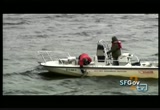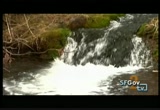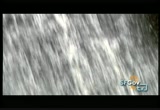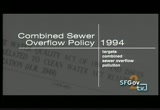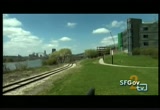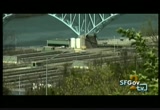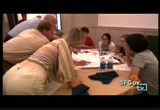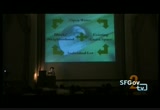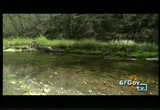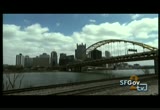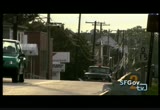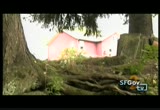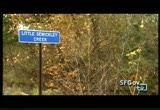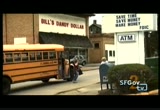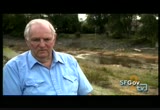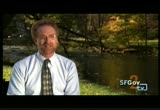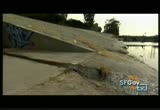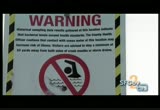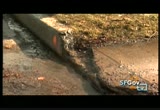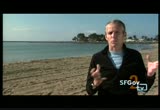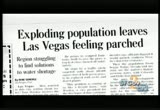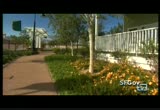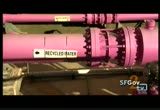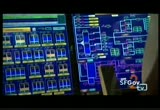tv [untitled] December 3, 2012 6:30am-7:00am PST
6:30 am
where we can really keep it clean enough to drink unfiltered for the indefinite future. and new york city is in a small club of cities that actually have that filtration avoidance waiver. narrator: while municipalities are responsible for maintaining systems and source supply, the standards that protect water are established at the federal level. there are two important pieces of federal legislation that were both enacted in the early to mid-1970s. the first was the clean water act, which acts to protect rivers and lakes, and sources of drinking water. the second was the safe drinking water act, that provides federal standards to assure the safety of the water that we drink. both acts have been amended since they were first adopted, and they're both cornerstones for the water issues
6:31 am
that we face in america today. allbee: the clean water act set a floor and basically said, "everybody's who's discharging "is going to have to have a permit, and to achieve this defined performance level." narrator: the clean water act regulates the discharge of pollutants into surface waters across the nation. it protects our watersheds, our recreational waters, and our drinking water intakes. man: today, more than 50% of the nation's waters are fishable, swimmable. that's almost doubled since the clean water act was passed in '72. narrator: another significant component of the clean water act was a federally funded grant program to build wastewater treatment plants to reduce pollution in the waterways. and many cities built their treatment plants with this grant money. oberstar: but even a decade after it was enacted, the reagan administration came in
6:32 am
and cut the grant program to a loan program. and funding diminished over a period of time. now, we still have 1/3 or more of the nation's streams and lakes that don't meet the standards of the clean water act. we have to advance the cause. that is the big challenge ahead of us. you just don't think of raw sewage in waterways in a developed country, and yet, that's what we have, and not just in pittsburgh, but all over. narrator: pittsburgh is situated at the confluence of the allegheny, monongahela, and ohio rivers. these three rivers are vital for industry, recreation, and drinking water. and each year, billions of gallons of combined sewer overflows discharge directly
6:33 am
into those rivers. hecht: we're now having to face the consequences of the choice that was made to put in combined sewer systems. narrator: in 1994, the government adopted a combined sewer overflow policy to reduce csos nationwide. cities with combined sewer overflows now face an enforcement action called a consent decree. under a consent decree, a city must reduce pollution levels significantly within a strict time frame or face heavy fines. in 1960, the combined sewer overflows were a perfectly legitimate way of dealing with sewers. woman: the mind set was that, what did it matter if we were sending our waste downstream? water was a good conveyance for pollution. man: sewer systems are installed to reduce public health problems.
6:34 am
now what you're doing is transferring the problem, you're transferring it to downstream cities. in addition, cities and towns above pittsburgh were doing the same thing. and then they were affecting the water intakes of pittsburgh. 90% of this region gets its drinking water from those same rivers that we have overflows occurring. hecht: we have sewage overflow with as little as 1/10" inch of rain. and our average storm here is a 1/4" storm. lichte: over a year's period, 16 billion gallons' worth of combined sewage and stormwater overflows into our rivers. tarr: it's not a problem of point "x" and point "y" alone. this is a watershed problem. a watershed problem. lichte: the watershed encompasses many municipal boundaries and it doesn't know any local politics. narrator: in the pittsburgh system,
6:35 am
83 cities and towns use the same sewage treatment plant -- alcosan. so all 83 municipalities have to work together to address the problem. schombert: we know we have billions of dollars that will have to be spent over the next 15 to 20 years. you can't do that wisely when you have 83 separate government agencies making decisions. the municipal consent orders and the alcosan consent decree require that the municipalities participate in a long-term, regional wet weather control plan. narrator: the information gathered in the initial research phase of the wet weather control plan will inform the large-scale infrastructure overhaul. and, as this research moves forward, pittsburgh is also working with environmental groups that are cleaning up the watershed. woman: make that connection. man: like a mural on the side of a building? woman: $5.00 to get in. man: there's water flowing under the ground right now. i really think a lot of people don't know that.
6:36 am
that's a critical area, because everything that's dropped on the ground is part of your watershed now. hecht: we have a very big focus on citizen engagement and community involvement. i'm thinking it's applicable beyond just this boundary. we see that as the most important long-term investment. man: you don't really get anything done until you start charging people. why not? they're not subsidizing or incentivizing that. hecht: every individual citizen is part of the problem and therefore every citizen has to be part of the solution. those are the street trees we want people to be planting. we do a lot of tree plantings. all of you must intuitively go, "of course it's good to plant trees," of course, i want to put a rain barrel on my house." but is there a measurable environmental impact? trees are going to take up a lot of stormwater over time and are kind of a long-term green investment. we've had more than 200 volunteers come out planting street trees. we need people to make active changes on their property. and to reduce the amount of flow that's going into the combined sewer lines, we're trying to install 4,000 rain barrels.
6:37 am
narrator: homeowners can disconnect roof gutter downspouts from the sewer system and divert the stormwater into a rain barrel. schombert: the rain water then can be used to water lawns and gardens and infiltrate back in the ground slowly, rather than being piped to a creek where it disappears moments after the storm's over. it's being held within the watershed and it helps regenerate ground water and stream flows. hecht: that's what we're going to do this afternoon is think about how to get more of those people involved. if there's less water in the streets, there will be less water in the pipes, less sewage overflow. narrator: in addition to mobilizing individual property owners, the watershed association undertook a project to restore the nine mile run stream in urban pittsburgh. schombert: the urban impacts on that watershed have been enormous. flooding flows, combined sewer overflows, gave it the nickname of "stink creek" for many, many years. hecht: before the stream restoration, when you have a rain event, the stream would just be
6:38 am
barreling, just filled with tons and tons of water, and the water would move very quickly, eroding the stream banks further. narrator: the rushing water ran all the combined sewage straight into the monongahela river, which is a main supplier of drinking water for the region. hecht: what has happened because of the restoration is the water overflows its banks, it floods into these nice flood plains with native plants. and then slowly the water percolates back down into the stream. narrator: this allows the land to naturally filter and clean the sewer overflows before they enter the river. the restoration included extensive environmental changes to improve the stream and infrastructure changes to reduce the csos into the watershed. hecht: when i first started talking with people about stream restoration, i kind of imagined people out with shovels and small-scale.
6:39 am
this is a massive $7.7 million project. schombert: nine mile run watershed is the most significant urban watershed restoration ever done in the united states. narrator: small-scale projects like nine mile run have far-reaching environmental impact. but they're just one part of the regional wet weather control plan. schombert: this region needs to solve its problem by 2026. that's not that long away. this is the largest public works project ever undertaken in this region. lichte: you're looking at significant infrastructure. either tunnels or storage tanks, or, you know, treatment facilities. the cost is about $3 billion. lichte: if you look at some of the other cities that have gone through this, their rates have gone up significantly. the federal government provides a number of grant programs but the bottom line is, you know, it's not enough. there's a massive need of money out there
6:40 am
for wastewater and water infrastructure improvements around the country. narrator: the struggle for funds is as great in small towns as it is in metropolitan areas. oberstar: the federal government has let down municipalities. the first investment under the '72 clean water act was to deal with the biggest waste streams. and after a period of six or seven years, to then go to municipalities under 250,000 population. but that was just about the time when the federal government converted to a loan program. so smaller-sized communities have had to deal with repayable loans. a larger cost on a smaller tax base, and, arguably, less affluent communities. man: sewickley township is a rural farming community, however, herminie itself would be considered to be the downtown area of the township. it's the agways, the auto-parts store, the bank.
6:41 am
it's your typical small-town village. man: people think that rural areas are pristine and perfect and everybody has a nice, simple life. that's, uh, not exactly the situation here. when you come into town in the summer, you know you're coming to herminie. woman: the aroma in 90-degree days... can sometimes just want to knock you over. woman: we have water. we have power, we have gas, but we have no sewage. i guess when they laid out the town years ago, it just all went into the pipes and straight into the "crick." sabljak: i've lived here 43 years in the same house. when i moved here, they told us that sewage would be here shortly. and here it is 43 years later and we still don't have it.
6:42 am
my husband and i went to the first meeting. he always said, "boy, i'll never see it in my lifetime." well... my husband passed away last december. man: right now, the wastewater in herminie is going to basically three places -- in the street, down mine shafts, or into the creeks. i think we're very lucky that we haven't had some kind of serious health problem. sabljak: i came up one morning to get my newspaper, and there was this pool of stench up here. there was a pipe spouting, like a fountain, with everything coming out. everything was on the road already. i could see toilet paper. i could see other things that were... that you would put in a sewer. mcmillen: well, i was actually born and raised in westmoreland county so i have been aware of the conditions in herminie all my life.
6:43 am
herminie has declined, because for any type of business of any size to come in and create jobs, they need the infrastructure there, and in herminie, it's just not there. narrator: to address community frustrations, sewickley township, home of herminie, created a sewer authority board in 1998. it's comprised of residents and business owners who worked for almost a decade to get sewage infrastructure for the area. miller: we were novices. i don't think anybody in the township knew where to go. and we were frustrated at times. we thought we were right on the cusp of getting funding, and then, something happened and we didn't get it. yeah, we could go out and float a loan, and probably people would be looking at maybe $100 a month in sewage bills. so what you have to try to do is get enough funding to keep sewage rates at a reasonable rate so people can afford them. and that's been a real problem. without grant money, it can't be done. mcmillen: they were in line, waiting for our money.
6:44 am
they had an application on my desk. but when someone has no funding, usually they sit and wait. the problem is, the amount of money given in the federal budget and the state budget is just not enough to fund infrastructure. we have a $200 million backlog on my desk alone. and that would be our entire state's allocation for 4, 5, or 6 years. schwartz: the usda asked that i go to herminie and provide an independent evaluation of the problems to determine if it was severe enough to warrant funding. i've worked in a lot of communities in pennsylvania, i've seen a lot of things that were pretty startling, however, the trip to herminie absolutely, um... astounded me. i wrote a letter to usda, saying that it was the worst thing i'd ever seen in pennsylvania and that if they could award funding, that they do so. and they did.
6:45 am
they did. over $15 million, grant and loan, for that project. mcmillen: and it took years to get funding. what kept this project going was the steadfastness of the community -- they knew they needed sewage, and they just kept plugging along till we got through every issue that came up. the project will consist of 44 miles of line that we're going to put in, and a treatment plant. it will permanently eliminate the problem, the health hazards. i anticipate a definite regrowth in herminie, and it will be a good thing for everybody. zdravecky: maybe it won't help me too much because i'm an old lady, but whoever comes along after me will get the benefit. schwartz: there's nothing isolated about the herminie situation. it's a very common problem. it's a town that was built before current standards. this is not backwoods rural america at all.
6:46 am
it's just an unfortunate situation that was created probably a hundred years ago or more. and the people have to pay for it in a big way now. because the government is choosing to spend its money elsewhere right now, there's very limited money for communities to install adequate drinking water and wastewater, and i think it's criminal. that's my feeling. this country has to get its priorities right, and they're wrong right now. narrator: herminie faces problems because of the way its residents laid out the town generations earlier. across the country, many other cities and towns deal with the unexpected consequences from their early infrastructure design. los angeles county is a land of sprawling development. with development comes hundreds of square miles of concrete, leaving no way for water to naturally soak into the ground.
6:47 am
in areas of such widespread urbanization, flooding can be devastating. man: back in early 1930s, there was a flooding that took a lot of lives and property. as a result, the city of los angeles, in order to protect future flooding in the city, they decided to take the los angeles river and make it a flood control channel. they concreted the walls of the river in order for water to get to ocean much faster. narrator: cities throughout southern california converted natural rivers to these concrete channels, part of their storm drain systems. this allowed expanding development without the need for large flood plains. kharaghani: the los angeles river is approximately 51 miles. concrete reduces the size of the river that you need to carry the water because it speeds up the flow of water. if you'd like to remove all the concrete and to have natural system to carry the water
6:48 am
to protect you from flooding, you need to have almost one mile on each side of the river set aside for transport of rain. so in order for the city to have use of those lands around the river, concrete made it possible to have minimum land so the water can be carried to the ocean in the fastest possible way. but, unfortunately, because of population growth and poor housekeeping, people are putting a lot of pollutants on the street and the streets are the openings to our stormwater sewer system. in an average year, 4,000 to 5,000 tons of trash ends up in long beach. man: we've created a system to deal with flooding but inadvertently created a pathway for pollution to get into our waterways. narrator: los angeles county is beginning to develop ways to reduce the infrastructure's impact upon the environment. on the front lines of protecting the beaches, are the crews that clean out the stormwater system.
6:49 am
man: this big vactor truck works on the same principle as your vacuum cleaner in your house, only this thing sucks up the whole house. some of the storm drains collect a lot of trash. i started cleaning drains in '93. they were horrible because they hadn't been maintained so much. now this is a priority. you have trash, animal waste, and it ends up on our beaches. that is a health risk. that is one of the main reasons why we have to close the beaches after heavy rain. narrator: but even when it's not raining, water still enters the stormwater system, carrying pollutants. here on the west coast, a lot of our storm drain systems are separate from the sanitary sewer system, so if you dump something in the storm drain, it goes right to the ocean untreated. alamillo: we haven't had a major rainstorm in the last year or so yet there's a lot of water in this creek here.
6:50 am
i would say 20% of it is natural and the other 80% is runoff. shapiro: the purpose of the smurrf is to treat dry weather runoff, which is coming from storm drains. dry-weather runoff occurs when people waste water through washing their cars in the street, hosing down sidewalks and parking lots, their irrigation systems overspray. narrator: in a city of 12 million people, those seemingly small bits of wasted water accumulate to enormous amounts. shapiro: so all that ends up in our streets, ends up in catch basins, storm drains, into our storm drain system, and for some of the city, parts of the city, it ends up here at smurrf. 350,000 gallons come here on a daily basis, producing recycled water, and that can be reused for landscape irrigation and indoor toilet flushing. the pumps can only handle so much water, which is generally when it's not rain, the dry-weather runoff, so if you get a storm of a decent size,
6:51 am
the pumps will shut down automatically and the water will just continue to flow out into the ocean and it carries a lot of bacteria and people can get sick when they're swimming in the water near a flowing storm drain. everyone knows you don't go in the water for 72 hours after it rains. you just don't. this is the dirtiest beach in southern california. doheny beach. i've surfed this twice -- i've gotten sick both times. narrator: san juan creek, a concrete flood control channel, flows directly to doheny beach. moriarty: the concrete you can almost think of as a big water slide for pollutants to go to sea level. man: if it rains more than 2/10 of an inch, the county puts out a health advisory for all beaches in the county. that totaled 75 days in 2006. so it's sort of a frightening thing that it's so polluted that every time it rains, we have to stay out of the ocean for three days. moriarty: to be sick after surfing isn't like,
6:52 am
"oh, i have a runny nose," and tomorrow it's gone. can be a lot of different things. nelsen: they include gastroenteritis, which is an upset stomach, and sinus infections, ear infections, eye infections, and there's also virulent versions of streptococcus that can actually cause severe illness and even death. moriarty: our goal with surfrider foundation is essentially to have the city understand that the water is, in fact, dirty, and then work with the infrastructure and the various issues to change that. narrator: but building more systems and more plants can't work alone as a sustainable solution. and, as in pittsburgh, as in new york, part of the answer lies in protecting the watershed. nelsen: we need to reduce the amount of impervious surfaces in our watershed, which are surfaces that don't let the water soak in and then create more pervious surface, whether it's by having driveways that allow water to soak in or different landscaping to try to eliminate
6:53 am
the amount of runoff that comes off our land so that the system, even with the development it has, acts more like a natural system and filters that water. water quality and sewage infrastructure isn't the sexiest of political agendas, but by raising the awareness about water quality issues, we can create political pressure to get our issues solved. about 15 years ago, surfrider activists were protesting a beach for being polluted. the city council asked the police to escort them away. there was complete denial of the problem. 15 years later, water quality is on the agenda of every city council person in that local city, and that's completely a result of activists forcing the issue, surfrider and other local groups, saying, "hey, these water quality issues are real and you need to address them." and only until the public sort of creates that will will the politicians respond. narrator: while some cities deal with infrastructure issues,
6:54 am
others have concerns about the sustainability of water supplies. allbee: it's not just about the sustainability of the assets, it's about the sustainability of our water resources. parts of this country that thought of themselves as water rich 20, 30 years ago, now are discovering that they really are not water rich, they have source supply issues, they have serious questions about how they're going to accommodate additional growth in their communities. melosi: if we can find alternatives, we can preserve a water supply. conservation of water is a way of generating more water. allbee: we think that a household can actually reduce its water usage by about 30%. and that's hugely important in terms of the amount of infrastructure that community's going to require. narrator: las vegas is one of the fast-growing areas in the country. it's a relatively new city under constant construction.
6:55 am
but because it's in the arid mojave desert, the challenge of las vegas is supply. woman: all the growth and everything that's occurred in southern nevada has been with colorado river water. without it, the west as you know it today couldn't exist. narrator: to sustain their growing community with its limited supply, las vegas learned to be extremely efficient. mulroy: this is a desert, and it has its own beauty, but you have to get beyond what you're used to. as long as people recognize they're moving to the desert and give up this notion that they have to bring eastern vegetation with them and make the necessary adaptations in their own life, desert communities can continue to live. man: the biggest water user in the desert is turf.
6:56 am
turf uses a lot of irrigation and uses spray irrigation, so what we've done here is use artificial turf. you're never going to be able to achieve the look of back east or the look of, say, california, with subtropical plants, but our landscapes are still lush and use about 30% of what the subtropical landscape with turf would use. las vegas has adopted a drought tolerant ordinance. we're using less water today than we used five years ago, despite over 300,000 new residents. i think it's a pretty amazing example as to how a town can really turn on a dime if there's the political will and if the public gets behind it. narrator: even the casinos and resorts have adapted to efficient water use. mulroy: the las vegas strip uses only 3%
6:57 am
of all the water that we deliver. and when you think about it, it's the largest economic driver in the state, the largest employer, bar none. they knew they had to go the extra mile. and they've embraced conservation. and it's almost beyond belief that they're right now in the process of building another 15,000 rooms. southern nevada recycles 100% of its wastewater. so for every gallon we put back in the colorado, we can take an additional gallon out, or we send it to reuse facilities. and we deliver it to golf courses and parks and other outside applications. man: water's about a third of our budget. that's a lot of money. the lake right over here, 24 hours ago that was in somebody's house. it's been through a treatment plant. and now it's in our lake and we're watering with it.
6:58 am
narrator: these reuse and conservation techniques enable las vegas to exist in the desert. another important form of conservation is preventing leaks. man: every drop counts. all water systems have what they call an efficiency rating. so if you were to measure the water that goes into your system and compare it to the water that goes out, how much is unaccounted for? most states have a goal of 10%. ours is at only 5.5% right now. and we have plans to lower that to 4%. man: we actually have our entire distribution system mapped out in a computerized or electronic format. and we can locate our pipes, we can locate our valves, we can locate water meters that are out there. we've got small units installed in the distribution system.
6:59 am
and they actually listen for leaks. we can schedule the repair, minimize its impacts to the surrounding community, and it minimizes cost, because obviously, if you've got a leak that's been leaking for sometime, you're going to see a lot of undermining of the roadways, potential property damage. fisher: all the sensors in the field come into this location. these two operators behind me operate the entire water system, 24/7. so we can see all of our reservoirs, their elevations, whether they're going up or down, how much water we're getting from our two treatment plants. we try to move it very quickly through the system and serve it to our customers in the most economic and efficient manner. narrator: las vegas serves as an example for cities across the country, whether they have a limited supply or not. and many utilities can identify with the struggles that come with maintaining underground assets
111 Views
IN COLLECTIONS
SFGTV2: San Francisco Government Television Television Archive
Television Archive  Television Archive News Search Service
Television Archive News Search Service 
Uploaded by TV Archive on

 Live Music Archive
Live Music Archive Librivox Free Audio
Librivox Free Audio Metropolitan Museum
Metropolitan Museum Cleveland Museum of Art
Cleveland Museum of Art Internet Arcade
Internet Arcade Console Living Room
Console Living Room Open Library
Open Library American Libraries
American Libraries TV News
TV News Understanding 9/11
Understanding 9/11